One Day In Oslo Itinerary – Your Ultimate Guide
Looking for the perfect one day in Oslo itinerary?
Oslo is the capital of Norway and a beautiful city we visited as part of our month-long road trip through Norway. It’s one of those fun capital cities that has a great vibe about it, loads of outdoor space and plenty of fun free things to do if you’re on a budget. And because it’s so relaxed you can explore it at your own pace without ever feeling too rushed. We enjoyed it so much that we’ve put together a perfect day in Oslo itinerary which will give you a full day of the best things to do there.
What we really loved about it is that most of the main attractions are within walking distance which makes it really easy to get around, especially if you’re visiting Oslo with kids. So, we’ve tried to plan our one day in Olso so that you can easily do most of it on foot.
We’ve also given you a few options so that you can swap things out or add them in depending on what you love to do. If we’ve tried and tested the attraction or activity then you’ll see our ⭐T&T⭐ icon next to it. We hope that you have a great time in Oslo and love what we’ve put together for you.
Quick Guide – One Day In Oslo
Morning – The Akershus Fortress then along the waterfront to Bjørvika to discover the Oslo Opera House. Afterwards, walk along the Karl Johans Gate up to the Royal Palace.
Lunchtime – Watch the changing of the guard and head to Aker Brygge for lunch.
Afternoon – Explore the islands off of Oslo harbour. Then spend the rest of the day either in Frogner Park or at Bygdøy exploring the museums
Evening – Dinner at Oslo Street Food
One Day In Oslo – Morning
Akershus Fortress ⭐T&T⭐
The Akershus Fortress dates back to 1299, as well as the fortifications it houses a stunning medieval castle that dates to the 1300s. It survived several sieges and was eventually upgraded into a full-on royal residence in the early 1600s, and since then it has been expanded and improved over time. The fortress was surrendered to the Germans during World War Two and was then liberated again in 1945.
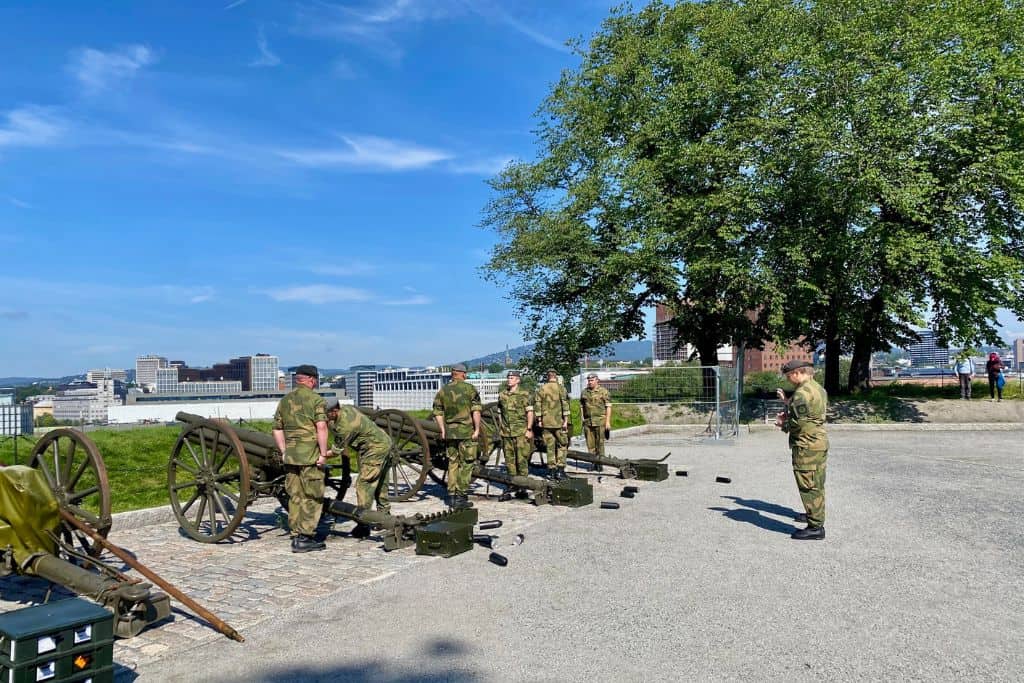
Entrance to the fortress is free which is especially great because it has amazing views over Oslo! There are several museums on site which charge a small entrance fee and you take a guided tour during the summer months by heading to the visitor centre. We didn’t visit the museums instead we explored it at our pace and spend time enjoying the fantastic views. On the day that we were there, the army was practicing firing the cannons because later that day they had to fire them to celebrate the prince’s birthday. Cam thought that this was very cool, and he loved getting to meet the “boss man” who was responsible for the management of the fortress.
Heading up to the Akershus Fortress first thing in the morning is a great way to start your day because it’s open from 6am. This means that you can get there whenever works best for you. This is particularly great if you’re an early riser or have “early rising” kid like we do!
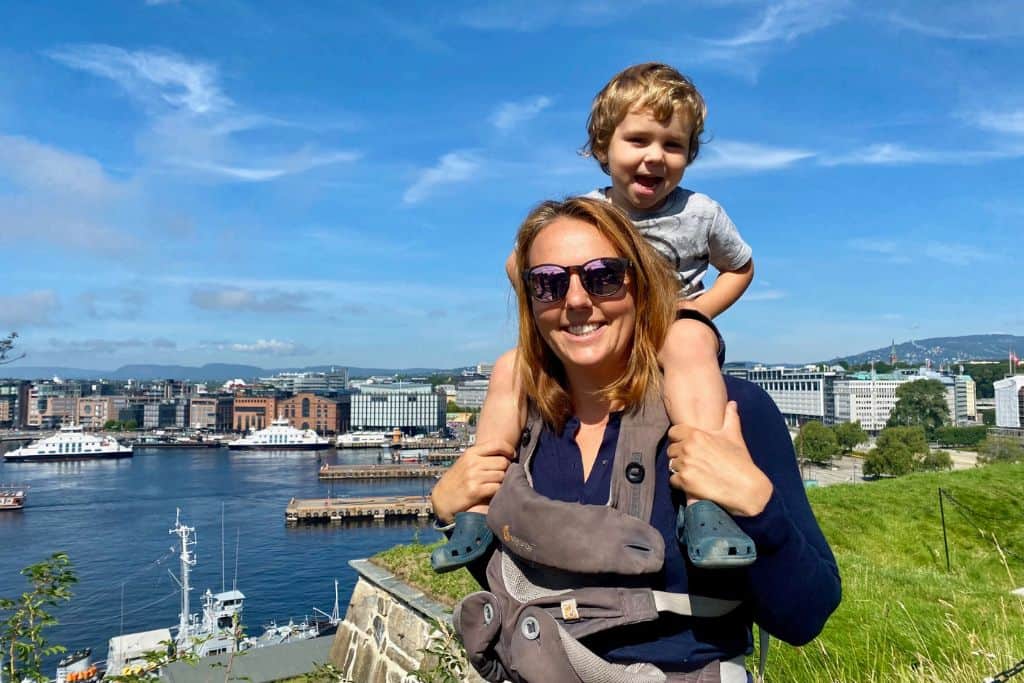
Head over to the Bjørvika neighbourhood ⭐T&T⭐
The Bjørvika neighbourhood of Olso is just a 15-minute walk from the Akershus Fortress. The area is famous for being the home of the Oslo Opera House, the Public Library and the Munch Museum. The area has been part of a push to develop this part of the waterfront, and the main attractions have all been built since 2008. What we loved about the area is that it was fun to walk around. Plus, there was quite a bit to do in a small area.
Top tip: If you’re visiting Oslo with kids then Bjørvika has a great city centre play area here that you should try. We loved it because there is also a great bakery called Backstube Opera that serves fab coffee and tasty pastries!
The Oslo Opera House (built 2008) ⭐T&T⭐
The Oslo Opera House is the home of the Norwegian National Opera and Ballet and the National Opera. Its main auditorium has seating for 1,364 people and its two other performance spaces can seat around 200 and 400 people each.
The draw of visiting is the chance to walk the ramps around the side of the building that go up to the top where you’ll get to see great views over the waterfront. You can literally walk from the bottom up to the top – it’s such a fun walk up. There’s also free entry into the building if you’re into modern architecture and want to explore it further and guided tours in English for a fee.
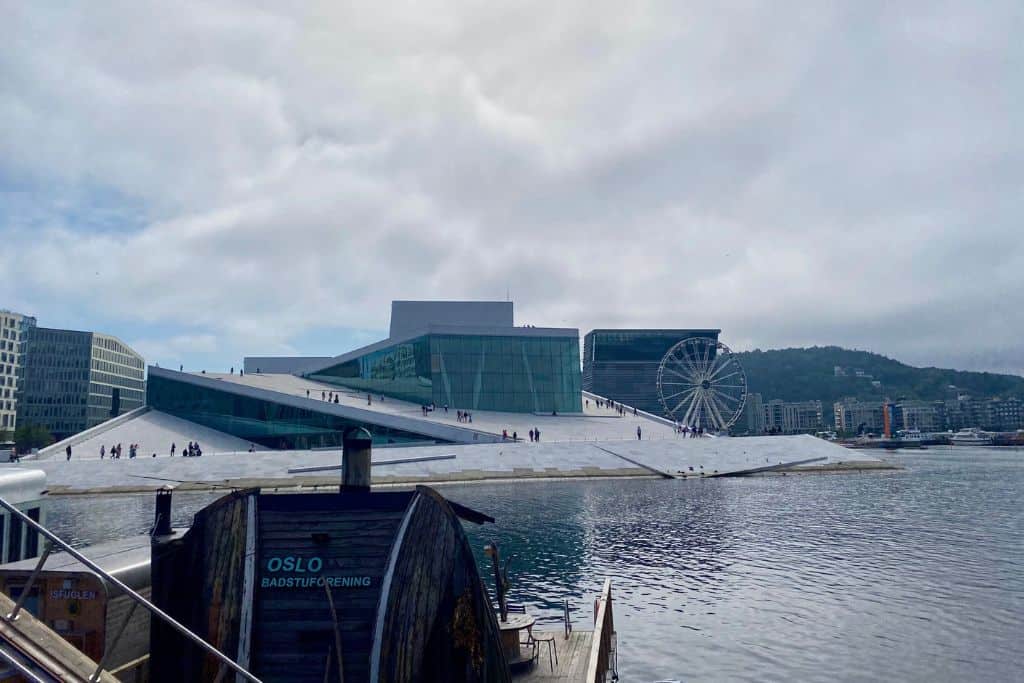
Oslo Public Library (built 2020) ⭐T&T⭐
The Oslo Public Library (Deichman Biblotek) is shaped like a shelf of books with the top “shelf” offset at an angle. It’s free entry to visit the library and it has loads on offer such as a dedicated children’s area, workshops, cinema cafe, and space to relax. If you ride the escalator all the way to the top then you’ll have a great view of the waterfront.
We spent some time in there as we realised that Cam hadn’t been to a library of that size before. He absolutely loved taking a look around and was hooked on watching this cool art installation where you watched an animation and listened to the plants “talking”. It’s a great place to head to if you need somewhere to take a break from the sunshine or cold depending on the season.
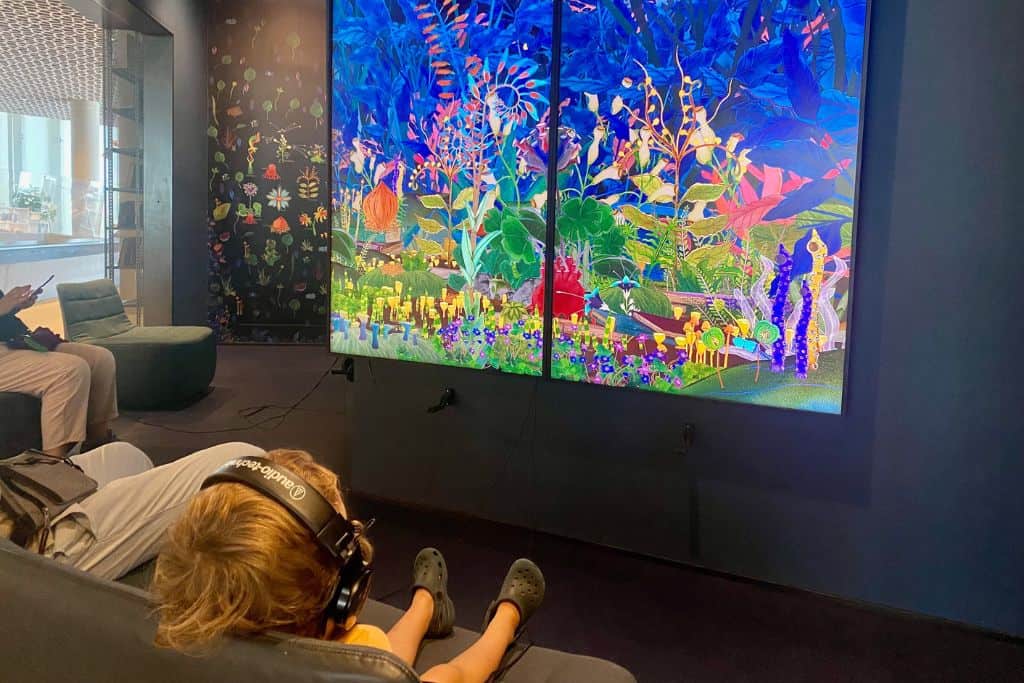
Top tip: There are free toilets in the library if you need them!
MUNCH Museum (built 2020)
The MUNCH Museum is dedicated to the life and works of the Norwegian artist Edvard Munch. Munch is most famous for his painting The Scream. Interestingly there are three different “The Scream” pictures at the museum. You’ll find them in a specially built black room that protects them from the UV found in daylight. One is a painting, one is a drawing, and the other is a print. They are each displayed on a rotation so that each hour, a different version of the artwork is unveiled whilst the others remain hidden. This is done to protect them from being in constant light because the UV can affect the coloured pigment. It takes great timing and some good luck to be there at the right time to see your favourite The Scream.
There’s a small charge to enter the museum and this is a must see for art lovers. We didn’t visit on this trip. That’s because we had our two very young boys with us, and they’re not particularly into galleries or museums yet. It’ll have to remain on our Oslo bucket list of things to do.
Top tip: MUNCH museum is free admission on the Oslo Pass if you have one!
Explore Karl Johans Gate ⭐T&T⭐
Karl Johans Gate is a 1.5km boulevard that connects Oslo Central Station at one end with the Royal Palace at the other end. It’s said that this main street is a replica of the Champs-Élysées in Paris and was designed on the request of Karl XIV Johan. He was King of Sweden and Norway between 1818-1844. Walking along it you’ll pass some of the most important buildings in Oslo. These include the Stortinget (Houses of Parliament), as well as cafes, restaurants and designer shops.
If you walk the 1.5km without stopping, it would take around 20 minutes to walk. However, there’s loads of fun stuff to distract you along the way, so expect it to take an hour or two! One of our favourite things was taking time to enjoy the street entertainment such as live musicians and artists. We’ve put together a list of some of the fun things you can expect to see on your walk to the Royal Palace.
Starting at Oslo Central Station ⭐T&T⭐

Just a short 5-minute walk from the Oslo Opera House is the Oslo Central Station (the main train station). The station is the start of the Karl Johans Gate boulevard. Here you’ll find an incredible (and very large) bronze statue called “The Tiger” which was gifted to the city on its 1,000th anniversary.
Fun fact: Oslo is nicknamed “The Tiger City” which is why it has such a massive tiger statue in the centre!
Oslo Cathedral ⭐T&T⭐
Oslo Cathedral also called Oslo Domkirke was built between 1694-97 in the Baroque style and later changed, in the 1850s, to the Neo-Gothic style. During the 1960s they restored the cathedral and discovered many artefacts and decorations from the 18th century. Today the cathedral still plays an important part in Norwegian Royal Family life and is regularly used for weddings and funerals. It’s a beautiful combination of architecture and artwork. We admired it from the outside but decided not to go in, however, we saw that it offers free entry.
Window shopping and street entertainment ⭐T&T⭐
The next section of Karl Johans Gate is where you’ll find the shopping and, our favourite, the street entertainment. From a shopping perspective you’ll find a mix of souvenir shops, high street brands such as H&M as well as designers such as Louis Vuitton. There are also lots of cafes and bakeries if you need to grab a snack along the way. We spent much longer here than we thought we would. That’s because our sons just loved listening to the buskers and watching the artists. We ended up buying a piece of spray paint art that was created especially for us which was pretty cool. It’s such a lovely memory of our time in Oslo.

Eidsvolls Plass and the Stortinget ⭐T&T⭐
At Eidsvolls Plass you’ll find a beautiful small park in the middle of the city with space to relax, a water fountain and some cafes. Surrounding the park are several important buildings such as the National Theater and Oslo University. However, the most important of them is the Stortinget which is the Norwegian Parliament. It’s a fantastic Parliament building and there are some great boards outside that explain the history behind the Stortinget.
One Day In Oslo – Lunchtime
Explore the Royal Palace and gardens ⭐T&T⭐
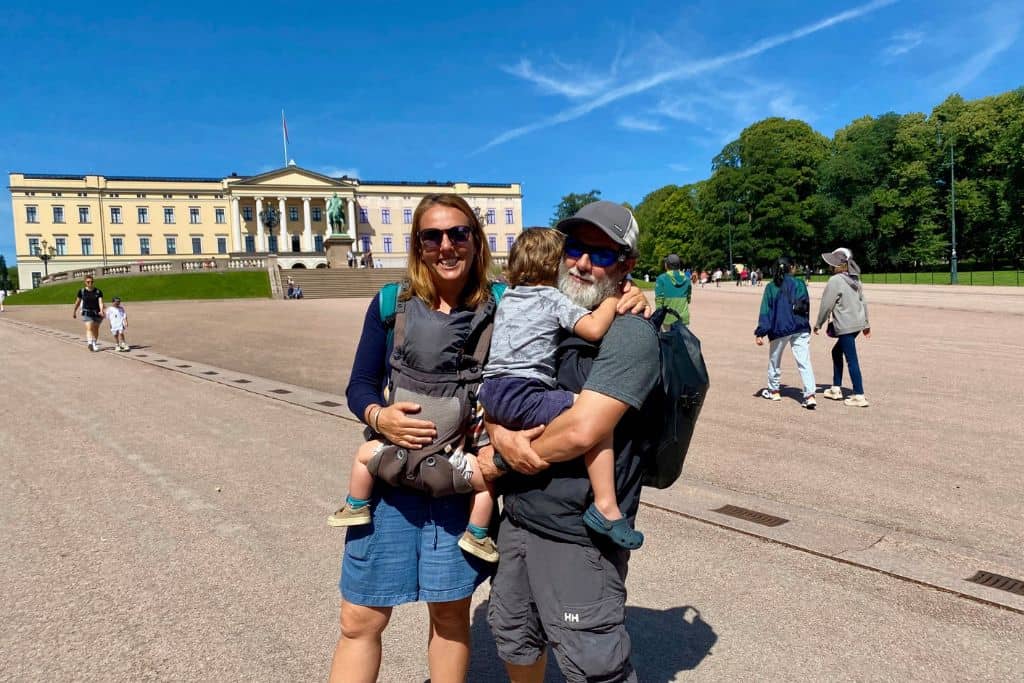
At the far end of Karl Johans Gate is The Royal Palace which is home to the Norwegian Royal Family. During the summer you can book in for a free tour of the palace. Which makes it one of the best places to head if you’re looking for free things to do in Oslo. All year round you can walk around and enjoy the stunning palace gardens. At 1:30pm every day, no matter the weather, there is a changing of the guard ceremony to enjoy.
We were super excited to watch the changing of the guard. However, we were a little underwhelmed as it was all over in 15 minutes. We’d read that there is sometimes a marching band and that the ceremony lasts up to 40 minutes. Which might be the case outside of the summer months. Either way, it’s a fun thing to head up for a good-sized crown arrives that you can people-watch.

Discover the Aker Brygge ⭐T&T⭐
The waterfront in Oslo is a great place to head for lunch as there are lots of fun places to eat. It was a former shipyard and has now been remodelled into a hip area. It’s got restaurants and cafes as well as a boat bar in the summer. You’ll also find these cool floating saunas that you can book into. The Aker Brygge is part of a 9km promenade that also connects to the Akershus Fortress and Oslo Opera House. We enjoyed watching the tour boats and ferries coming in whilst we relaxed in the sunshine. This is another great place for relaxing.
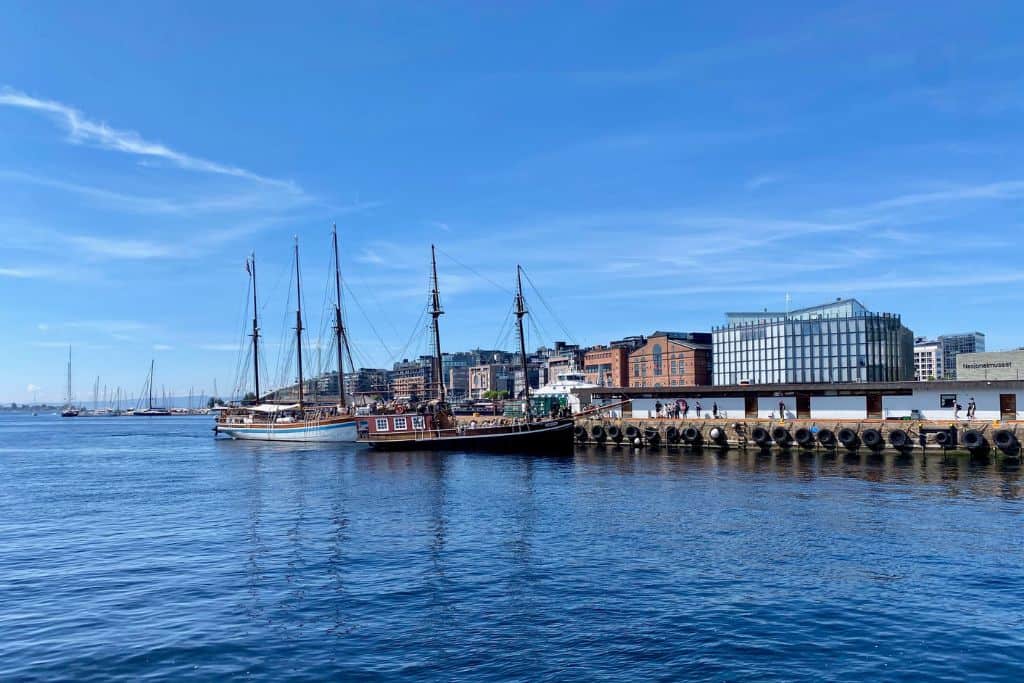
Near the Aker Brygge you’ll also find Oslo City Hall. You can spot it by its two tall red brick towers, one of which has a clock face on it. The hall was opened in 1950 and is most famous for hosting the Nobel Peace Prize ceremony every year. We didn’t have time to go inside, however, we did see that there is free entry every day before 12pm.
One Day In Oslo – Afternoon
Enjoy a boat tour around Olso’s islands ⭐T&T⭐
After enjoying Aker Brygge you can spend an hour or two our on the water seeing Oslo from a different perspective by discovering Oslofjord and it’s surrounding islands. Less dramatic than the Western fjords such as Geirangerfjord, it’s still a beautiful area to explore and learn more about. There is a huge variety of boat tours that you can join, such as cruise style boats as well as sailing yachts, and some even have meals and music included.
In the summer months the waterways of Oslo get particularly busy with ferries that head out to the nearby islands where locals and visitors alike head to relax and swim in the sunshine. If you’re on a budget, like we were, then taking one of the ferries is a great way to explore Oslofjord. That’s because they’re part of the public transport network, so you’ll just pay a single fare for the entire 45 minute ride. During our stay, we did the loop and then the following day took a ferry over to Hovedøya island for a few hours to swim.
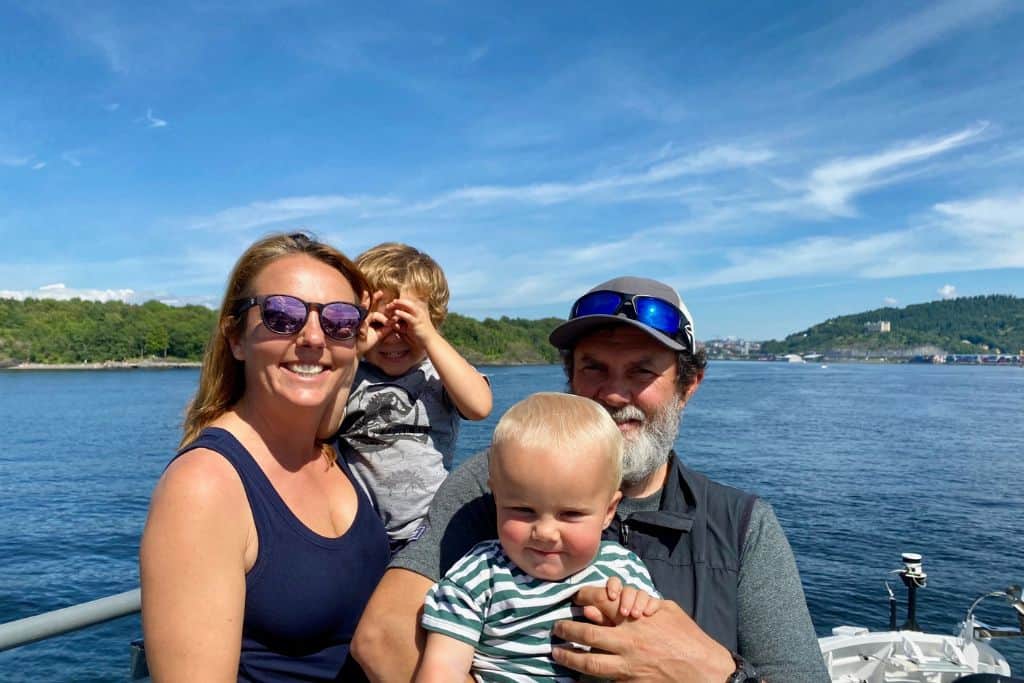
Either explore Frogner Park or discover Bygdøy ⭐T&T⭐
For the last few hours of the day we’ve suggested a choce between two main attractions. You can either explore Frogner Park and it’s Vigeland Sculpture Park or discover Bygdøy the “museum peninsula”.
Frogner Park and the Vigeland Sculpture Park ⭐T&T⭐
Frogner Park is the largest park in central Oslo and just 20 minutes by public transport from Aker Brygge. As well as being a large green park it also has some other great things to do there,. You’ll find a kids playground, lake, cafe and manor house that is now a museum. The park has also got a public swimming baths that’s open in the summer months and is made up of 2 swimming pools, a kids pool and slide. As well as these attractions it’s also home to the Vigeland Sculpture Park
Top tip: If you have kids with you, then Frogner Park is home to Norways biggest playground and shouldn’t be missed!
Vigeland Sculpture Park is inside Frogner Park and has more than 200 bronze statues by Gustav Vigeland. It the world’s largest sculpture park with works by a single artist. The sculptures are human figures in all sorts of settings and positions. Some are of women holding children whilst others will have you second guessing what exactly they are doing (if you get what we mean!). One of the most famous is of a crying young boy called “Angry Boy”. You can find him on the bridge and you’ll spot people regularly stopping to pose by holding his hand.
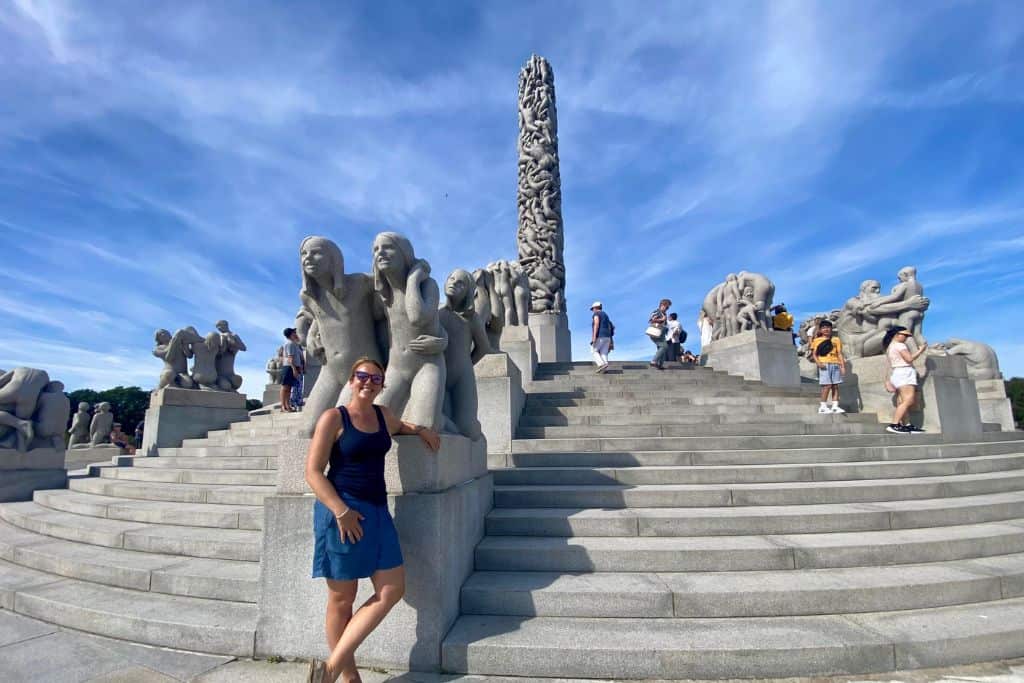
Vigeland Park is a the perfect place to explore if you’re an art lover and want to spend some more time outdoors.
Discover Bygdøy the “museum peninsula”
Bygdøy is famous for its nature trails, museums and farming and is popularly called the “museum peninsula”. It was originally the royal hunting grounds. Then in the mid 1800s King Karl Johan bought the surrounding buildings to create a large recreation park. By 1882 the worlds first open-air museum was opened on the island. It’s purpose was to collect historical buildings and tell the stories of Norwegian culture and history. If you decide to head to the Bygdøy peninsula then it is a great opportunity to explore some of the many museums that Oslo has to offer.
We’d have loved to have visited to go to Oslo’s Viking Ship Museum, as Cam has really got into Vikings during our trip, however, as it’s closed (reopening 2027) so we decided that it would be more fun for the kids if we headed to Frogner Park with them. There are many museums to explore and we’ve listed out the most popular that you might want to discover as part of your visit to Bygdøy.
Norwegian Museum of Cultural History
Known as the Norsk Folkemuseum – with over 160 historic buildings this is one of the worlds largest open air museums. It’s got lots of activities and experiences to bring the space alive. You’ll get to see how they lived in various times in different parts of Norway. One of the most famous historic buildings is the Gol Stave Church which is a beautiful building dating back to the 1200s.
Fram Museum
It tells the story of Norwegian polar exploration. It specifically focuses on a polar exploring ship called Fram. Fram was launched in 1891 which you can see the original ship in the museum.
Kon-Tiki Museum
It tells the story of the adventures of Norwegian adventurer Thor Heyerdahl. He famously built a raft out of balsa wood and sailed across the Pacific Ocean in it in 1947.
Oslo’s Viking Ship Museum
Sadly, this museum is currently closed and not due to reopen until 2027. It is famous for having three large well-preserved Viking ships. They are called the Oseberg ship, the Gokestad ship and the Tune ship.
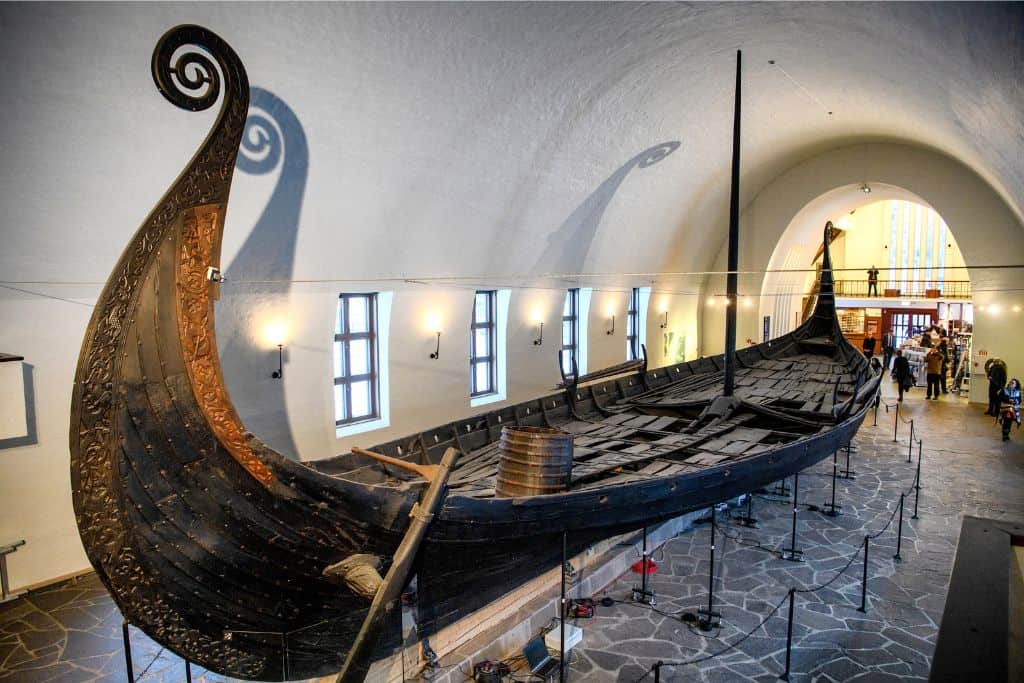
Top tip: All of the museums in Bygdøy charge admission. However, they are all free admission on the Oslo Pass if you have one!
One Day In Oslo – Evening
Dinner at Oslo Street Food ⭐T&T⭐
Oslo Street Food is the perfect place if you’re into the street food vibe, are looking for a budget option and love a fun atmosphere. There are loads of dining options from Taco’s to chicken wings to poke bowls! We headed there a few times in the early evening as its great for families as there are so many dining options. We saw lots of other families there too at that time. Later in the night, it gets a bit more full on and we’ve heard there are DJ’s and live music!

Have More Than One Day – Other Things To Do In Oslo
If you have more than one full day in Oslo, then there are loads of other great things that you can do. We’ve gathered a few ideas to share with you below.
Holmenkollen Ski Museum. It was founded in 1923 this is the world’s oldest ski museum. Some of the artefacts go back 4,000 years and they even have skis from the Viking age.
Nordmarka. Just a short tram ride from the city centre. This recreation park is where locals come to enjoy hiking in the summer and cross-country skiing in the winter
The Botanical Garden. You’ll find it in the Tøyen area of Oslo. This large garden is home to around 1800 species of plants. Plus, it also has large woven sculptures by the British artist Tom Hare.
How To Get Around In Oslo
The great thing about Oslo is that you can easily walk or cycle between most of the main attractions. If you’re keen to cycle then you can either rent bikes from a shop. Or, you can use the city bikes where you scan an app and rent the bike per ride. We chose to cycle as it was much easier with young kids than to ask them to walk between places. Another option, is to hop onto an e-scooter if they’re your thing. We did a little bit of e-scootering with this kids when they got too tired to cycle.

If you’re looking to use the metro or bus then you’ll be pleased to hear that Oslo has a really well organised and efficient public transportation system. All of the information that you need easily available on the Ruter app. There are loads of ticket options and you can buy daily passes too. Just a note that the daily passes don’t don’t include the ferries between the islands and the Bygdøy peninsula.
We also spotted that it has several “hop on hop off” bus companies that you can ride. They’re great and we particularly love a hop on hop off bus with our kids because you can listen to the audio guide as you go. Plus, it gives you the flexibility to go at your own pace. We did one recently in Lisbon with our kids which was a big hit!
What Is The Oslo Pass?
The Oslo Pass give you free admission to 30 museums and sites, plus unlimited travel on the public transportation system. Plus discounts and offers at restaurants, tour companies, concerts, events and much more. If you’re are going to use public transport and love museums then it can work out as great value to buy an Oslo Pass.
Final Thoughts On One Day In Oslo
Oslo is an incredible city, we had such a great time there. We were only there for 3 days, which isn’t much time because there are so many fun things to do in Oslo. However, if you’re visiting for one day in Oslo then you can easily fit in most of the main attractions. We’ve definitely got the Norwegian capital firmly on our list of places to visit again!
Other great places to visit in Norway include Geiranger, Olden, Bergen and Flåm.
